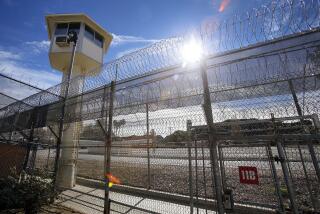Emergency Preparedness Behind Bars
- Share via
In the event of a major disaster resulting in massive injuries, ordinary citizens throughout Southern California could call the police or fire departments, hospitals or other agencies that would provide aid within any city.
However, thousands of prisoners, guards and other administrators who essentially compose small towns within jails throughout Southern California would not have access to city aid, but nonetheless could need medical care or other help, said Barry King, custody division chief for the Los Angeles County Sheriff’s Department.
“Obviously, [inmates] have shown they don’t want to obey the regulations of society,” he said.
“But we’re here to house them, not to punish them. In any custody situation we have to provide everything that a city provides.”
To meet that need, the Sheriff’s Department recently instituted the Emergency Medical Response program, which would utilize 30 medically trained reserve deputies from the Lost Hills and Santa Clarita stations who would report to the Pitchess Detention Center near Castaic in the aftermath of a disaster causing massive injuries.
Aside from natural disasters, the department also has to be prepared for injuries caused by the inmates themselves, King said.
The jail has a history of frequent racial brawls--mostly between African Americans and Latinos--although those have rarely resulted in serious injuries. Most of those hurt in these melees have been treated at jail wards at hospitals such as County/USC Medical Center.
The department already has other response programs--involving as many as 2,000 other reserve deputies--and holds regular drills that focus on, for instance, how the department would respond to a big fire at the jail or a major disturbance.
The Pitchess jail already has a medical staff, including dentists and nurses, who perform routine treatments, King said.
So if the reserve deputies were called upon, they would assist that staff with the overload.
“It’s part of a process to give us supplemental support,” he said.
Pitchess is a county jail consisting of four separate holding facilities--the North, East and South facilities and the North County Correctional Facility.
On any given day, there are approximately 6,200 inmates there--some serving short sentences but most awaiting trial or other court action, King said. The number of guards on hand is kept confidential for security reasons.
The reserve deputies in the new program are Emergency Medical Technicians--one level below paramedics. They would be summoned through a pager system activated by an incident commander if their services become necessary after a disaster or jail uprising.
“That would be assuming they are not on another call,” King said. “We would not pull them off from a call [treating civilian victims].”
The reserve deputies have their own vans equipped with various emergency gear--from bandages to gurneys, King said.
Some details still need to be ironed out, King said. But within the next four months the department will hold a drill to test the program.
“So far, we’ve been very lucky,” King said, pointing to the jail’s relatively low number of serious injuries. But “we are constantly evaluating our whole response systems.”
More to Read
Sign up for Essential California
The most important California stories and recommendations in your inbox every morning.
You may occasionally receive promotional content from the Los Angeles Times.










